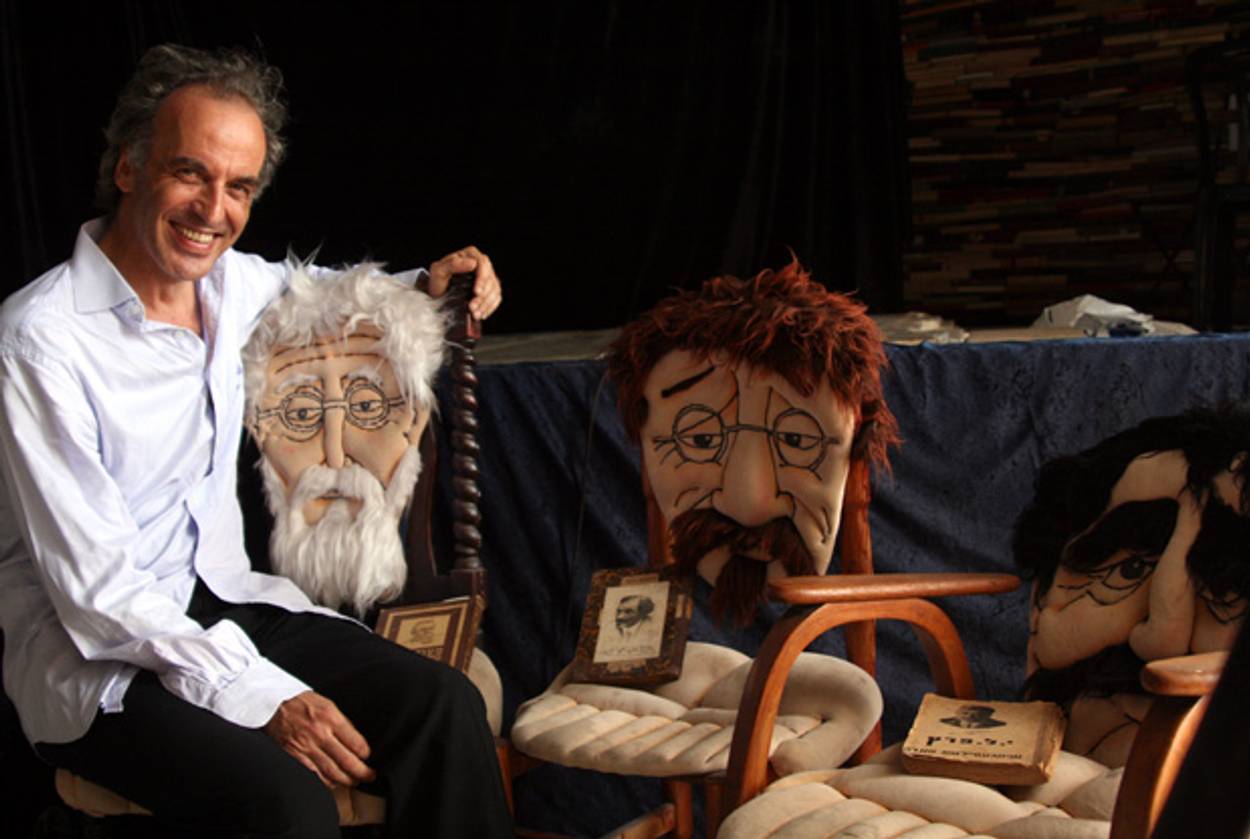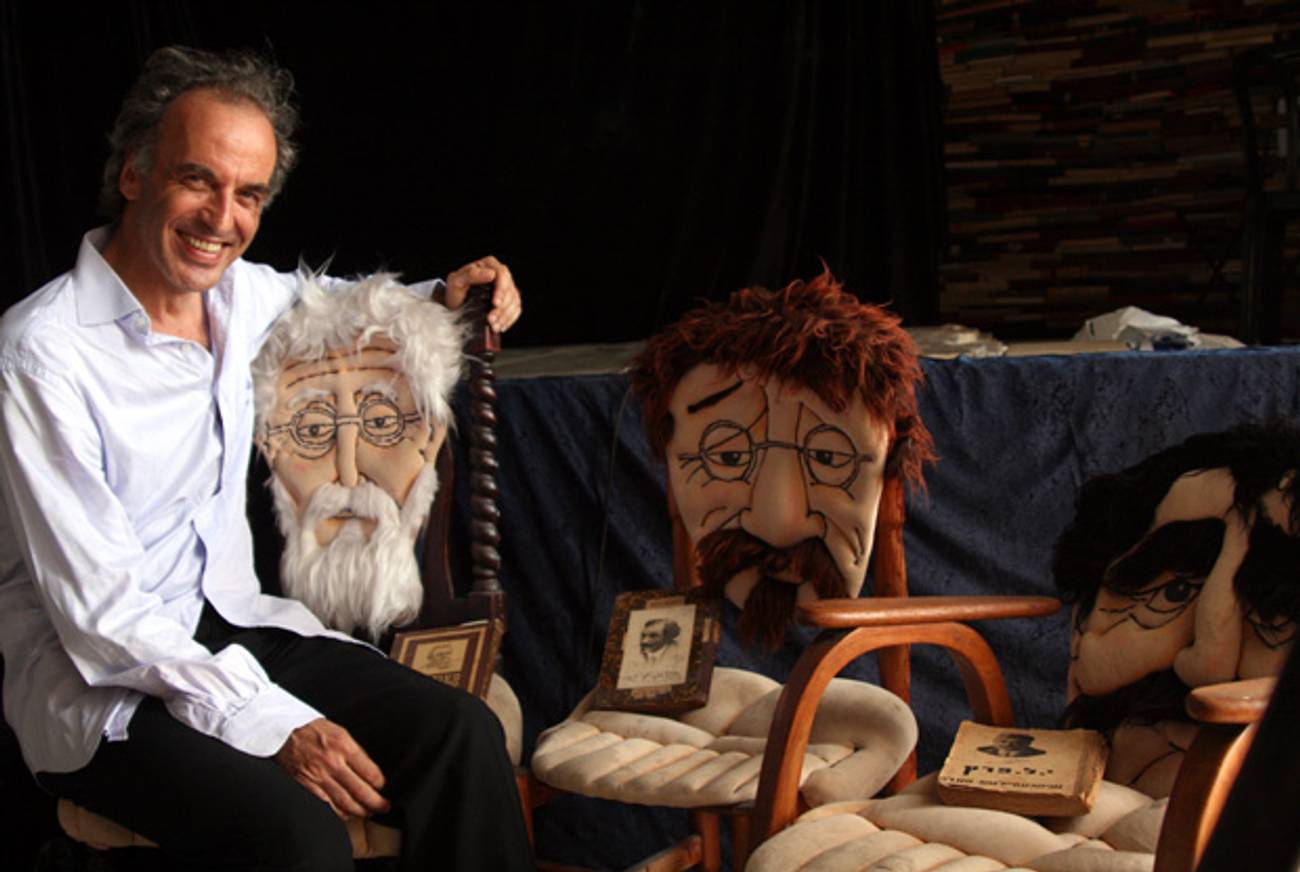Mother Tongue
A passionate, crusading Yiddisher tries to keep the Eastern European language alive in the cosmopolitan center of the Jewish state




It is hard to imagine a less charming venue for a concert than Tel Aviv’s Central Bus Station, a grimy, labyrinthine, seven-story tower in the city’s most drug-addled neighborhood. Even less likely is that such a concert would be held in Yiddish. But on a night in early January, when Mendy Cahan crooned there in the mama loshen, surrounded by a cavernous collection of Yiddish books illuminated by candlelight, the experience was transformative. “Me without you and you without me is like a handle without a door, like eating without a table,”Cahan sang in Yiddish to visiting French singer Miléna Kartowski, who joined him in a duet. The only reminder of the odd locale was the sound of passing buses on the ramps outside.
Cahan, 48, grew up speaking Yiddish in Antwerp, Belgium, and is determined to save the language from extinction in the Jewish state, where he has lived for the past 30 years. He’s the first to concede he is not the best administrator:He owes roughly $40,000 to city hall for overdue property taxes, he smokes Camel cigarettes inside his library of 40,000 old books, and his meager budget provides the collection with no protection from Tel Aviv’s oppressive summer humidity.
But Cahan, who speaks Hebrew and English as well, also bears a quixotic passion for fully living in the half-dead language he loves. In summer he teaches Yiddish and performs musicals in his native tongue in Lithuania and Poland. He is also the lead singer in the band Mendy Cahan & Der Yiddish Express. On their 2005 album Yiddish Fever he sings translations of “Summertime” and “Fever,” along with other Yiddish classics and his own compositions. He whispers, sighs, and languorously wanders through the words, evoking the full range of emotion in a language often confined to old folk songs.
“After having paved the way through hundreds of years to build Jewish identity, finally we build our homeland,” he told me in English. “I find it unacceptable and wrong if Yiddish would not find its respectful, loving space.”
***
The first time I met Cahan, he was declaiming a poem by I.L. Peretz for a Russian television segment, which happened to be filming at the height of the summer’s protests in Tel Aviv. “Man!” he shouted in Yiddish, while piano accompanist Amnon Fischer read out the Hebrew translation. “Do not think life is a saloon, where everyone can push his way forward with his shoulders and eat and drink while others are watching from afar with glassy eyes and empty stomachs.”
Cahan’s receding mane of gray hair matched his bushy gray eyebrows and piercing blue eyes as he paced the stage. Behind him was a wall of books, the duplicates of works in Yiddish that he did not have the heart to throw away. At the other end of the library was a plastic pool with “a few fishelach,” as he called the fish he had brought to lighten the dusty mood. Three chairs stood together near the stage, their backs each sewn in the images of the greats of Yiddish literature: the gray-bearded Mendele Mocher Sforim, the redhead Sholom Aleichem, and I.L. Peretz, with a black tuft of hair to match his thick moustache. “We are friends, the books and I,” Cahan said. “I think they are in a better place than in a paper mill.”
A walking monument to gathering scattered pieces of a whole, Cahan wore a brown vest whose pockets bulged with two passports, four notebooks, a wallet, a yellow box of cigarettes, a city tax bill, vitamins, reading glasses, a USB drive, a mobile flip phone, tissues, a crumpled 20-shekel note, a lighter, and keys. Cahan said that when he immigrated to Israel from Belgium in 1980, he was surprised to see how sidelined his native tongue had become there.
“Many people spoke Yiddish,” Cahan said of the Israel he encountered. “They would read and meet in clubs, but it seemed as if it wasn’t a part of the whole Israeli experience.” In 1990, he started collecting books. At first, Cahan housed his collection in a dilapidated building in an industrial zone in Jerusalem. He then opened a second library in Tel Aviv. He named the organization overseeing the two libraries “Yung YiDish” in an effort to expand the Yiddish circle beyond the elderly. Yung YiDish is one of several Tel Aviv institutions—some 80 years old, and some open less than a decade—that are doing what they can to revive and preserve the tongue that once united the Jews of Eastern Europe, by teaching the language, offering theater, and printing books.
Cahan said it costs $150,000 to $200,000 to properly run Yung YiDish, but private donors provide only half of that. For the rest, he lives by the seat of his pants, begging city hall for a break on his taxes and meeting with the Ministry of Culture to ask for government funding. Cahan spreads word of his center while teaching in Eastern Europe and performing in cities around the world with significant Jewish populations. He dreams of holding Yiddish-cuisine cooking lessons. And he hopes to eventually sponsor translations of Yiddish classics into English, French, and Chinese and continue to promote Yiddish music and film. “Yiddish is more than just the shtetl,” he said.
***
Yiddish, an amalgam of German, Hebrew, and Aramaic written in Hebrew characters, was once the main Jewish dialect in Eastern Europe. But in Israel it was seen as the prime competition to the revival of Hebrew, according to Avraham Novershtern, the director of the Beth Shalom Aleichem Yiddish cultural center in Tel Aviv. “There was a conscious decision which began in early 20th century that Hebrew would be the language of the new state, and in that decision, there was violence against Yiddish,” said Novershtern. He described incidents of kiosks being burnt for selling Yiddish papers. In the 1930s and ’40s, Yiddish movies were sometimes kept from screens. Fights broke out on the streets over the public use of Yiddish.
Along with this intimidation, there emerged a movement to preserve the old language. The Association of Yiddish Writers and Journalists was founded in 1928; it has been housed in Tel Aviv’s Beit Leivik since 1970 and has printed more than 100 books. The current chairman, Daniel Galay, said he notices a recent change in the status of Yiddish, which he also grew up speaking in Argentina. More and more students are signing up for language courses, including about 20 this year. Twenty years ago, Galay said, “the opposition to Yiddish was still very strong. There were pro-Yiddish waves, in the 1980s, and but it went up and down. Today the situation is different.”
Tel Aviv remains at the center of the Yiddish revival in Israel, as most of the city’s residents trace their roots to Eastern Europe. While Orthodox Jews in Jerusalem also speak Yiddish, they are not connected to the secular literature and courses offered in the coastal city.
Eliezer Ceizler, assistant director of productions and administration at Tel Aviv’s Yiddishpiel Yiddish theater, which was founded in 1987, said the company now runs more than 300 plays a year in theaters and retirement homes around Israel. This month, the theater is performing God, Man, and the Devil, a play about a simple, religious man who wins the lottery. Most of his audience is older, Ceizler said, but he also sees younger Yiddish speakers.
A spokeswoman for the Ministry of Education said that about 500 high-school students will likely take the Yiddish matriculation exam in 2012, up from 400 the year before.
Cahan said he has also developed a lecture for Israeli high-school students preparing to visit the concentration camps of Eastern Europe. “About the destruction they will hear plenty,” he said. “I bring newspapers and books and magazines to their classrooms so they can touch and feel and get a sense of the life that was”—and the language that was spoken there.
No area of culture is off limits. In his Yung YiDish centers in Jerusalem and Tel Aviv, Cahan runs Yiddish cabaret nights. He has also hosted events to eat herring and kugel, and he welcomes young actors and artists to rehearse and throw parties in his library. “Yiddish culture connects so many different segments of society,” he said. “Russian immigrants, secular Israelis, tourists from all over the world, the religious, and the very religious—the kaleidoscope of multiplicity in Jewish society today.”
***
For all the recent enthusiasm in Israel for Yiddish, however, its biggest champions acknowledge that reviving the language is an ongoing struggle. The generation of people who speak it as a mother tongue is aging. Cahan said the Yiddish classes in Israeli high schools have mostly been disappointing. “You teach a few songs and that’s it,” Cahan said. “There’s still some real interest missing, like why should we teach the kids Yiddish at all.”
Novershtern said that Yiddish’s revival speaks to Tel Aviv’s growing role as Israel’s cosmopolitan heart. “Israel is a more open society, more open to cultural discoveries, and the Yiddish culture blends into this trend,” he said. “Before, the approach was more of a monopoly, or exclusive role of the Hebrew, Zionist culture. And in the last few years there is more openness.”
Galay cautioned against complacency. “There is nothing to promise that today’s revival will continue,” he said. “The interest, the learning, the lectures are all stronger today, but there is nothing that promises it won’t disappear in a year.”
And so, though it is the language of Israel’s founders, today Yiddish competes with the panoply of cultures mixing in Tel Aviv. The Yung YiDish center embodies that tension. It is one of 1,600 enterprises in the bus station, sharing a corridor with a Filipina-Israeli matchmaking agency, a kindergarten for children of migrant workers, and an Israeli artists’ collective. Outside, the nearby Neve Shaanan pedestrian walkway is crowded with Ethiopian and Sudanese restaurants, Asian dry good stores, and Western Union money-transfer storefronts. Cahan said he enjoys the variety. Over the summer, he offered his library to migrant workers’ children who needed a place to read.
“I feel very much at home in Neve Shaanan,” Cahan said. “When I go there I see the Lower East Side of New York in the 1920s. There’s not necessarily Yiddish on the streets, but I feel there’s a natural parallel.”
Daniella Cheslow is an American journalist covering the Middle East.
Daniella Cheslow is an American journalist covering the Middle East.